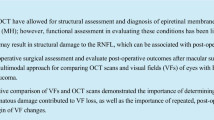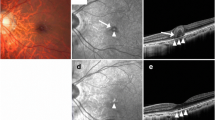Abstract
Background
Macular translocation can be associated with visual improvement, but patients often experience symptoms of confusion or diplopia. There is a high incidence of suppression of the operated or the fellow eye. The aim of this study is to use computer software to examine the pre- and post-operative fundal images, in order to better understand how patients see after macular translocation surgery.
Methods
We created a graphical user interface that allowed a user to identify and record common landmark points in pre- and post-operative fundal images. We used these points to carry out interpolations using two algorithms, namely bilinear and thin-plate spline transformations. The transformations were applied to the Mona Lisa in order to appreciate how patients might see.
Results
Given two sets of corresponding points, both algorithms were able to approximate the effect of the surgery. Bilinear transformation was able to account for changes to the retina as a whole, including rotation, stretches, compression and shear. The thin-plate spline algorithm additionally accounted for the considerable regional and uneven local effects. Applying the later algorithm to the Mona Lisa produced inconsistent and warped images.
Conclusions
Our results confirmed that neurosensory redistribution was associated with most cases of MT360. We infer from these results that corresponding retinal elements between two eyes would no longer correspond after surgery. The distortion of images from the operated eye could not be completely corrected by squint surgery, and this may account for the high incidence of suppression of the fellow or the operated eye after surgery.




Similar content being viewed by others
References
Abdel-Meguid A, Lappas A, Hartmann K, Auer F, Schrage N, Thumann G, Kirchhof B (2003) One year follow-up of macular translocation with 360 degree retinotomy in patients with age related macular degeneration. Br J Ophthalmol 87(5):615–621
Buffenn AN, de Juan E, Fujii G, Hunter DG (2001) Diplopia after limited macular translocation surgery. J AAPOS 5:388–394
Denion E, Ordonez J-R, Klein J-C, Glacet-Bernard Walter T, Caputo G (2007) Redistribution of the neurosensory retina in inferior limited macular translocation: an evaluation using image registration. Graefes Arch Clin Exp Ophthalmol 245:437–442
Eckardt C, Eckardt U, Conrad HG (1999) Macular rotation with and without counter-rotation of the globe in patients with age-related macular degeneration. Graefes Arch Clin Exp Ophthalmol 237:313–325
Fricke J, Neugebauer A, Nobis H, Bartz-Schmidt KU, Russmann W (2000) Counterrotation of the globe in macular translocation. Graefes Arch Clin Exp Ophthalmol 238:664–668
Glasbey CA, Mardia KV (1998) A review of image warping methods. J Appl Stat 25:155–171
Lindsey P, Finkelstein D, D’Anna S (1983) Experimental retinal rotation. Investig Ophthalmol Vis Sci (Suppl) 24:242
Loomis JM, Philbeck JW, Zahorik P (2002) Dissociation between location and shape in visual space. J Exp Psychol 28(5):1202–1212
Machemer R, Steinhorst UH (1993) Retinal Separation, retinotomy, and macular relocation: II. A surgical approach for age-related macular degeneration? Graefes Arch Clin Exp Ophthalmol 231:635–641
Mehta J, Wong D, Farnell DJJ (2008) Tilt adaptation in patients following large degrees of macular translocation and counter-rotation surgery for AMD. (unpublished)
Neugebauer A, Fricke J (2002) Sensory problems after macular translocation. Ophthalmologe 99:156–159
Sato M, Terasaki H, Ogino N et al (2003) Strabological findings after macular translocation surgery with 360° retinotomy. Investig Ophthalmol Vis Sci 44(5):1939–1944
Seaber JH, Machemer R (1997) Adaptation to monocular torsion after macular translocation. Graefes Arch Clin Exp Ophthalmol 235:76–81
Sonka M, Hlavac V, Boyle R (1999) Image processing, analysis, and machine vision (2nd Ed.). PWS Publishing, Pacific Grove CA, pp 62–68
Todd JT (2004) The visual perception of 3D shape. Trends Cogn Sci 8(3):115–121
Wong D, Lois N (2000) Foveal relocation by redistribution of the neurosensory retina. Br J Ophthalmol 84:352–357
Author information
Authors and Affiliations
Corresponding author
Additional information
Presentation: Some of the images formed part of the presentation of the Keynote speech at the SOE 2005, Berlin.
Proprietary Interest: none
Rights and permissions
About this article
Cite this article
Wong, D., Liazos, S., Mehta, J. et al. Macular translocation surgery: computer simulation of visual perception. Graefes Arch Clin Exp Ophthalmol 246, 831–836 (2008). https://doi.org/10.1007/s00417-008-0771-1
Received:
Revised:
Accepted:
Published:
Issue Date:
DOI: https://doi.org/10.1007/s00417-008-0771-1




